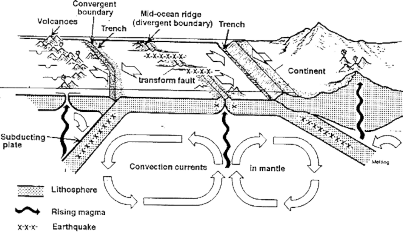3.3. Sea Floor Spreading
The hypothesis of sea-floor spreading was first put forward by Harry Hess in 1961. Post-drift studies had been able to establish the facts which were not available at the time of Wegener. These may be summarized as:
(a) The ocean crust rocks are much younger than the continental rocks. The age of rocks in the oceanic crust is nowhere more than 200 million years old compare to continental rocks out of which some are as old as 3,200 million years.
(b) The sediments on the ocean floor are unexpectedly very thin and thickness of the sediments increases with the distance from the ridge. They were only 6 to 7 km thick, whereas below the continental surfaces this thickness was 30 to 40 kms.
(c) Mid-oceanic ridge was not found only in Atlantic Ocean, but ridges were present in all the oceans. These ridges contain large scale evidences of faulting and volcanicity and are bringing huge amounts of lava to the surface.
(d) The rocks equidistant on either sides of the crest of mid-oceanic ridges show remarkable similarities in terms of period of formation, chemical compositions and magnetic properties. Rocks closer to the mid-oceanic ridges are of normal polarity and are the youngest. The age of the rocks increases as one moves away from the crest.
On the basis of above facts the realization dawned that the ocean floor possibly is the youngest and most active part of the earth’s surface. In 1961, Harry Hess argued that the ocean floor was mobile and

